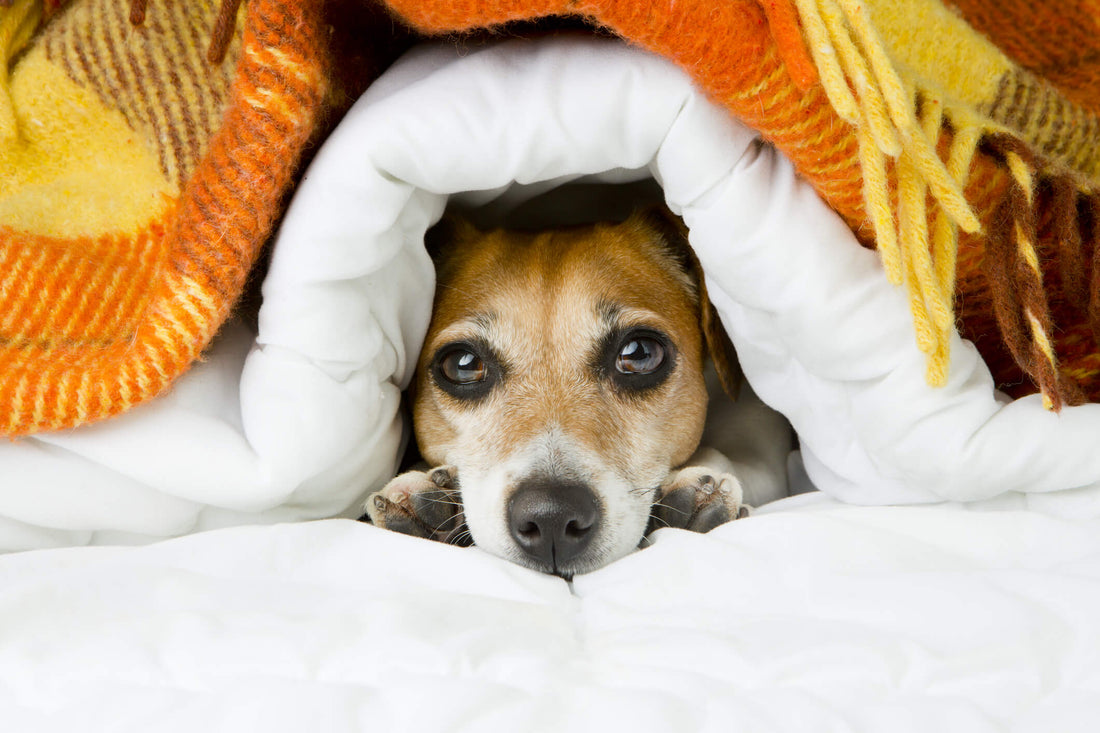Just like humans, dogs can experience fear, anxiety, and stress, often in response to unfamiliar situations, loud noises, or past trauma. A scared dog may display behaviours like cowering, shaking, hiding, barking excessively, or even acting aggressively in certain situations. While it’s heartbreaking to see a dog in distress, it’s important to understand that with patience, compassion, and the right strategies, you can help your dog feel more secure and confident. Here’s a guide on how to help a scared dog feel safe and calm.
1. Recognise the Signs of Fear and Anxiety
Before you can help a scared dog, it's essential to recognise the signs of fear. These can vary between dogs but often include:
- Shaking or trembling
- Hiding or trying to escape
- Whining, growling, or barking excessively
- Tucked tail or flattened ears
- Licking lips or yawning excessively
- Pacing or drooling
- Avoiding eye contact
Understanding when your dog is scared will help you tailor your approach and ensure they feel supported during their time of fear.
2. Create a Safe, Calm Space
One of the first steps in helping a scared dog is providing them with a space where they can retreat and feel safe. A quiet, cozy corner of the house with their bed, blankets, and favourite toys can be a great sanctuary for your dog.
- Provide a crate: Many dogs find comfort in their crates, as they provide a den-like environment. Make sure the crate is large enough for your dog to stand, turn around, and lie down comfortably. You can even add soft bedding and a piece of clothing with your scent to make it feel more familiar.
- Keep the space quiet: Try to minimise loud noises, traffic, or other distractions in the area. Close windows or use white noise to help block out external sounds that might be causing anxiety.
3. Use Positive Reinforcement and Rewards
When working with a scared dog, it's important to use positive reinforcement to help them associate fear-inducing situations with positive experiences. This technique can help build their confidence and reduce anxiety over time.
- Reward calm behavior: If your dog is exhibiting calm behavior in a fearful situation, offer them a treat or praise to reinforce that calmness. This helps them learn that calm behavior leads to good things.
- Desensitise to triggers: Gradually expose your dog to the things they fear, but at a distance that doesn’t cause them anxiety. For example, if your dog is scared of other dogs, allow them to observe from a safe distance and reward them for staying calm. Gradually decrease the distance over time, always pairing the experience with positive reinforcement.
4. Don't Force Interaction
It’s tempting to try and comfort a scared dog by petting or picking them up, but in some cases, this can cause more stress, especially if the dog is trying to hide or avoid you. Forcing interaction can make the dog feel cornered or trapped, escalating their anxiety.
- Respect their space: Let your dog come to you on their own terms. If they are hiding or not approaching, give them time and space to feel comfortable.
- Slow, gentle movements: If you do need to approach a scared dog, move slowly and gently to avoid startling them. Avoid making sudden movements, which might exacerbate their fear.
5. Use Calming Aids
In addition to behavioural changes, there are calming aids that can help soothe your dog. These can be particularly useful when your dog is experiencing intense fear or anxiety.
- Adaptil: Adaptil is a synthetic pheromone that mimics the calming signals mother dogs give to their puppies. It’s available in sprays, diffusers, and collars and can help reduce anxiety in fearful dogs.
- Calming music or white noise: Some dogs find comfort in calming music or background noise, which can drown out fear-triggering sounds like thunderstorms or fireworks.
- Thundershirt: A Thundershirt is a vest that applies gentle pressure to a dog's torso, mimicking the feeling of being hugged. This has been shown to help some dogs feel calmer during stressful events.
6. Stay Calm and Patient
Dogs are highly attuned to their owners' emotions. If you’re feeling anxious or frustrated, your dog may pick up on that energy and become more anxious themselves. It’s important to remain calm and patient when helping a scared dog.
- Speak in a soothing voice: Use a gentle, calm tone when talking to your dog. Avoid raising your voice or expressing frustration, as this can increase your dog’s anxiety.
- Be patient: Fear doesn’t go away overnight. It may take time for your dog to adjust to new situations or become more confident. Celebrate small victories, such as your dog approaching you or staying calm for a short period, and build on those successes over time.
7. Avoid Punishment or Negative Reinforcement
Never punish a dog for being scared. Punishment, such as yelling or scolding, can exacerbate fear and cause your dog to associate you with negative feelings. This can lead to an even more fearful or anxious dog, and may cause aggression in some cases.
- Don’t yell or scold: Fearful dogs are already under stress, and punishment can worsen their anxiety.
- Redirect behavior with rewards: If your dog is showing signs of fear or anxiety, redirect their focus with positive reinforcement instead of scolding them. Reward calm and confident behavior with treats or praise.
8. Provide Regular Exercise and Mental Stimulation
A tired dog is a calmer dog, and physical exercise can help reduce anxiety. Regular walks, playtime, and puzzle toys can help burn off excess energy and keep your dog’s mind occupied.
- Physical exercise: Take your dog on daily walks to help release any pent-up energy. Even just a short walk around the block can make a big difference.
- Mental enrichment: Use puzzle toys, treat-dispensing toys, or basic obedience training to keep your dog mentally stimulated. This can help reduce stress by providing an outlet for their energy and focus.
9. Seek Professional Help if Needed
If your dog’s fear or anxiety is severe and persistent, or if they’re showing signs of aggression due to fear, it may be time to consult a professional dog trainer or behaviorist. A professional can assess your dog’s behavior and create a tailored plan to address their specific needs.
- Certified trainers: Look for a trainer who uses positive reinforcement methods and has experience working with fearful or anxious dogs.
- Veterinary help: If your dog’s anxiety is extreme, your vet may recommend medications or other treatments to help alleviate their symptoms.
Conclusion
Helping a scared dog requires patience, compassion, and a consistent approach. By recognising the signs of fear, providing a safe and calm environment, using positive reinforcement, and seeking professional help if necessary, you can support your dog in overcoming their anxiety and build their confidence. Every dog is unique, and with time and care, you can help them feel more secure and happier in their world.

